Themed collection Horizons Community Board Collection: Advanced Memory Technologies

Horizons Community Board Collection – Progress and development in advanced memory technologies and electronics
A themed collection on advanced memory technologies, guest edited by Materials Horizons Community Board Member Ye Zhou and Nanoscale Horizons Community Board Member Pengzhan Sun.

Nanoscale Horiz., 2020,5, 1353-1354
https://doi.org/10.1039/D0NH90042G
Toward non-volatile photonic memory: concept, material and design
This review presents the development of photonic memory, with a view towards inspiring more intriguing ideas on the elegant selection of materials and design of novel device structures that may finally induce major progress in the fabrication and application of photonic memory.
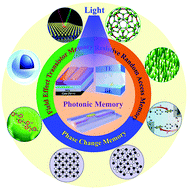
Mater. Horiz., 2018,5, 641-654
https://doi.org/10.1039/C8MH00110C
Current status and prospects of memristors based on novel 2D materials
A summary of the characteristics and switching mechanisms of memristors based on novel 2D materials.
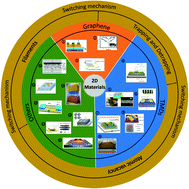
Mater. Horiz., 2020,7, 1495-1518
https://doi.org/10.1039/C9MH02033K
Nanotrapping memories
Nanotrapping memories are suggested as an enabler for a nano-empowered, data-centric future.

Nanoscale Horiz., 2019,4, 828-839
https://doi.org/10.1039/C9NH00076C
Real-time monitoring of trap dynamics reveals the electronic states that limit charge transport in crystalline organic semiconductors
Access to the dynamics of trap annihilation/generation resulting from isomer rearrangement identifies the performance-limiting processes in organic thin-film transistors.
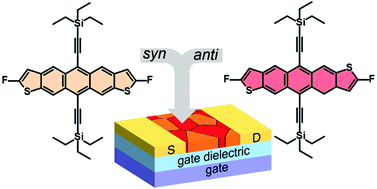
Mater. Horiz., 2020,7, 2390-2398
https://doi.org/10.1039/D0MH00706D
Monitoring supported lipid bilayers with n-type organic electrochemical transistors
An n-type, accumulation mode, microscale organic electrochemical transistor monitors the activity of a pore-forming protein integrated into a lipid bilayer.
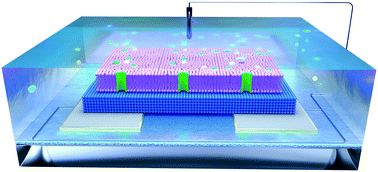
Mater. Horiz., 2020,7, 2348-2358
https://doi.org/10.1039/D0MH00548G
2D ferromagnetism in europium/graphene bilayers
Coupling to Eu makes graphene magnetic without sacrificing its intrinsic properties.
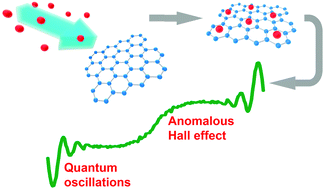
Mater. Horiz., 2020,7, 1372-1378
https://doi.org/10.1039/C9MH01988J
An asymmetric hot carrier tunneling van der Waals heterostructure for multibit optoelectronic memory
Novel optoelectronic memory is fabricated using a van der Waals heterostructure of PtS2/h-BN/graphene with asymmetric hot carrier tunneling barriers.
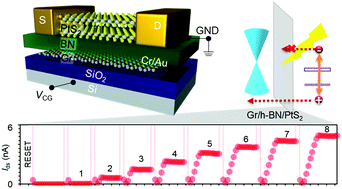
Mater. Horiz., 2020,7, 1331-1340
https://doi.org/10.1039/C9MH01923E
Beyond graphene oxide: laser engineering functionalized graphene for flexible electronics
We show a novel concept for the design of graphene-based materials via diazonium-mediated functionalization and subsequent laser treatment for flexible electronics.

Mater. Horiz., 2020,7, 1030-1041
https://doi.org/10.1039/C9MH01950B
Optically and electrically excited intermediate electronic states in donor:acceptor based OLEDs
Using spin-sensitive techniques, we show that optical excitation and electrical generation in donor:acceptor TADF OLEDs involve different excited state pathways towards light emission.
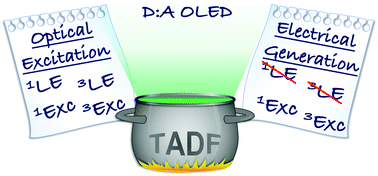
Mater. Horiz., 2020,7, 1126-1137
https://doi.org/10.1039/C9MH01475F
Designing carbon conductive filament memristor devices for memory and electronic synapse applications
Utilizing the instability of the edge atoms of graphene defects, carbon conductive filaments were formed under the regulation of the electric field and the synaptic function was achieved.

Mater. Horiz., 2020,7, 1106-1114
https://doi.org/10.1039/C9MH01684H
A multiple negative differential resistance heterojunction device and its circuit application to ternary static random access memory
For increasing the bit-density in the conventional binary logic system, various efforts have been made toward implementing single devices with two threshold voltage (VTH) via the negative differential resistance (NDR) phenomenon.

Nanoscale Horiz., 2020,5, 654-662
https://doi.org/10.1039/C9NH00631A
Electrochemical and thermodynamic processes of metal nanoclusters enabled biorealistic synapses and leaky-integrate-and-fire neurons
A two-terminal memristive device with embedded Ag nanoclusters is developed to biorealistically realize artificial synapses and leaky-integrate-and-fire neurons.

Mater. Horiz., 2020,7, 71-81
https://doi.org/10.1039/C9MH01206K
Comparison of organic and inorganic layers for structural templating of pentacene thin films
Effective control over the molecular orientation of pentacene was achieved with copper(I) iodide and results in a change in the functional properties with increases in both visible light absorption and work function.

Mater. Horiz., 2020,7, 289-298
https://doi.org/10.1039/C9MH00355J
Superionic conduction along ordered hydroxyl networks in molecular-thin nanosheets
Single-layer LDH nanosheets serve as a free hydroxide ion donor and 2D hopping lane for superionic conduction.

Mater. Horiz., 2019,6, 2087-2093
https://doi.org/10.1039/C9MH00549H
Fully transparent, flexible and waterproof synapses with pattern recognition in organic environments
Artificial intelligence applications require bio-inspired neuromorphic systems that consist of electronic synapses (e-synapses) able to perform learning and memory functions.

Nanoscale Horiz., 2019,4, 1293-1301
https://doi.org/10.1039/C9NH00341J
Ionic nanocluster-evolved polymers for low-voltage flexible organic nonvolatile memory transistors
The ionic nanocluster-evolved PAMPSA–AN layers enable nonvolatile memory OFETs to be operated at low voltages with outstanding retention characteristics.

Mater. Horiz., 2019,6, 1899-1904
https://doi.org/10.1039/C9MH00519F
Keggin-type polyoxometalate cluster as an active component for redox-based nonvolatile memory
Keggin-type polyoxometalate (POM) cluster based non-volatile memory has been investigated, and the molecular reconfiguration induced by the reduction process of POM molecules is proposed to initialize the resistive switching behavior.
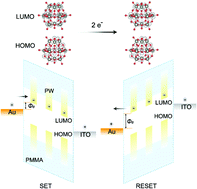
Nanoscale Horiz., 2019,4, 697-704
https://doi.org/10.1039/C8NH00366A
MoS2-capped CuxS nanocrystals: a new heterostructured geometry of transition metal dichalcogenides for broadband optoelectronics
Heterostructuring of different transition metal dichalcogenides (TMDs) leads to interesting band alignment and performance improvement, and thus enables new routes for the development of materials for next-generation semiconductor electronics.

Mater. Horiz., 2019,6, 587-594
https://doi.org/10.1039/C8MH00809D
Erasable memory properties of spectral selectivity modulated by temperature and bias in an individual CdS nanobelt-based photodetector
Single CdS nanobelt-based photodetectors show an ultra-high response to light close to the bandgap energy at large bias, and moreover their spectral response range selectivity to above- and below-bandgap light can show an reversable memory by temperature-writing and bias-erasing.
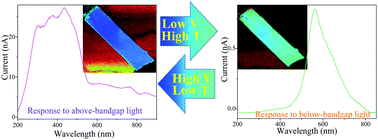
Nanoscale Horiz., 2019,4, 138-147
https://doi.org/10.1039/C8NH00182K
An all-solid-state biocompatible ion-to-electron transducer for bioelectronics
The first all solid state organic electrochemical transistor based upon the skin pigment melanin.
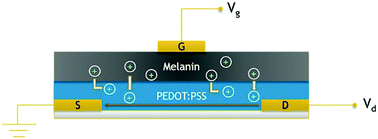
Mater. Horiz., 2018,5, 256-263
https://doi.org/10.1039/C7MH00831G
Light sensors and opto-logic gates based on organic electrochemical transistors
In this study, we combine a photochemical cell with a transistor, forming a novel optical-to-electronic interface using OECTs with a light-sensitive gate, which can be used for photonic, optogenetic and other applications where conversion from an optical to electronic signal is key.
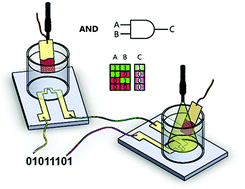
Mater. Horiz., 2018,5, 93-98
https://doi.org/10.1039/C7MH00818J
Unusual electromechanical response in rubrene single crystals
Multiscale modeling and experimental measurements highlight the strong coupling between mechanical stress and mobility along the two in-plane orthogonal crystalline directions in rubrene FETs.
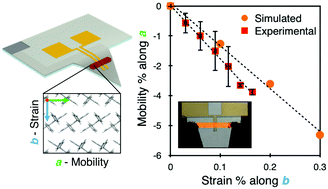
Mater. Horiz., 2018,5, 41-50
https://doi.org/10.1039/C7MH00489C
Nanometric building blocks for robust multifunctional molecular junctions
Multiple layers in molecular junctions with different structures permit a wide range of electronic functions, including rectification, memory, and charge storage.
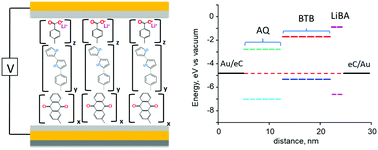
Nanoscale Horiz., 2018,3, 45-52
https://doi.org/10.1039/C7NH00109F
About this collection
Guest Edited by Ye Zhou, Shenzhen University and Materials Horizons Community Board member and Pengzhan Sun, University of Manchester and Nanoscale Horizons Community Board member.
Advanced memory technologies and electronics are impacting the information era. Many of the emerging memories and electronic devices, especially those constructed by appealing functional materials or methodologies, will play a key role in building novel, high speed and low power consumption computing and data storage systems. In this themed collection, we compile noteworthy research and review articles in the areas involving charge trapping memories, resistive memories, neruomorphic devices, and many other intriguing electronic devices and paradigms with new possibilities. We hope you enjoy reading this themed collection.